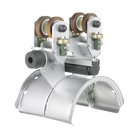Recommend
Remove File
Remove document <span id="remove-document-name"></span> from <span id="remove-cart-name"></span>?
Richmond Engineering Works teams up with Conductix-Wampfler to supply Rail Car Dumper Positioner System for an Atlantic coast terminal.
Moving bulk materials - coal, wood chips, grain, aggregate, or biomass – is being done more often by gondola cars rather than hopper cars. Hopper cars sacrifice space due to the bottom chutes and have a high center of gravity. Hopper dump doors can sometimes leak materials onto the tracks. Gondolas, however, must be picked up and dumped. An increasingly popular method of doing this is the “rotary dumper”, which secures the car and turns it completely to dump the contents.
Using a locomotive to position cars into the dumper is slow, inefficient, and inaccurate. A better option is to employ an indexing positioner to move cars into the dumper. Railcar positioners also help reduce or eliminate demurrage fees commonly associated with inefficient or slow unloading methods at export terminals, trans-load facilities, power plants and manufacturing facilities.
One of the terminals on the Atlantic seaboard recently chose a rack & pinion style railcar positioner, designed and supplied by Richmond Engineering Works (Pittsburgh, PA). Ken Hunt, engineer with REW, explained that, “the two REW Rack & Pinion Style Railcar Positioners are believed to be the largest of their kind in North America. They can handle up to 160 car trains with individual cars weighing up to 286 kip (286,000 pounds-force) for a total positioning capacity of nearly 45.8 billion pounds per train. The positioner can index the entire train as a coupled unit into the Rotary Car Dumper or it can handle smaller strings of rail cars.”
Mr. Hunt added that, “the drive system for this particular project consists of eight (8) 150-HP motors and gearbox assemblies controlled by off-board variable frequency drives (VFDs). One of the many challenges of this project was connecting the motors and other on-board equipment to the off-board controls and VFD’s as the positioner travels along a 400’ runway. It took several consultations with Conductix-Wampfler to specify the right festoon system for the job.
Richmond Engineering worked closely with Tim James, engineered product specialist at Conductix-Wampfler in the US, to arrive at a cable festoon to carry the shielded VFD power cables as well as the control and communication information to the control system. The entire positioner operation is controlled from a remotely located operator house with sensors providing the needed feedback to the operators. Mr. James noted that, “the massive festoon system was factory preassembled on a 53 ft. steel shipping frame. We believe it to be the largest preassembly we have done to date.” Tim went on to say, “the cable package consists of eight of 4/ 0 AWG 3 conductor VFD construction power cables one 2/0 AWG, 3 conductor power cable, one 1 AWG, 1 conductor grounding cable, one 12 AWG, 12 conductor power control cable, one 6x62.5/125 Fiber Optic cable, and eight 16 AWG, 3 conductor twisted and shielded pair control/signal cable. Active travel is 340 feet, with a loop depth of 10.50 feet, and cable weight per loop of 650 pounds.”
The Conductix-Wampfler festoon relies on their heavy duty 360 Series festoon trolleys each with a large two tier support saddle arrangement, 4.00” diameter steel main rollers with precision sealed bearings, 2.50” diameter side guide rollers, and 2.00” diameter anti-lift rollers. The trolleys are hot dipped galvanized with all stainless steel fasteners for corrosion protection.
Mr. James went on to say that, ”VFD AC motors operate at high frequency switching speeds which leads to electro-magnetic interference (EMI). EMI can radiate out and interfere with electrical equipment. The VFD construction power cables have the proper shielding to reduce the effects of (EMI), reflected standing waves, voltage spikes and Corona issues. This type of power cable is becoming more common with today’s VFD motors.”
With the success of this project, Richmond Engineering Works and Conductix-Wampfler expect to team up again for future rail car positioner projects.